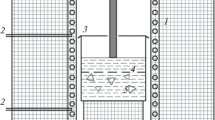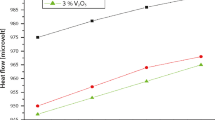Abstract
The formation of mullite via gels prepared from technical ethyl silicate and aluminium chlorides has been studied. Normally, gels prepared specifically with the oxide stoichiometry of mullite (3Al2O3·2SiO2) do not form the mineral mullite on firing to 1200° C in the absence of a mineralizer. However, when the stoichiometric gel is homogeneous (achieved by acidic or neutral catalysts during the gel preparation) firing at 1200° C can lead to an almost quantitative yield of mullite. For a homogeneous gel, the presence of strontium or caesium salts, or an organo-tin compound such as dibutyltin diacetate or dibutyltin oxide during the gel preparation promotes almost quantitative conversion to mullite at about 1000° C. There is a threshold concentration under which conversion to mullite is incomplete, some cristobalite being formed. For the organo-tin compounds, the type of aluminium chloride is unimportant and the way in which water for the hydrolysis step is added is also unimportant. When the gel is non-homogeneous, the product obtained on firing contains cristobalite andα-alumina orγ-alumina, with little mullite, even if strontium or caesium salts, or organ-otin compounds are present. A ceramic bond is formed from alumina and some other refractory grains during firing.
Similar content being viewed by others
References
J. W. Mellor, “A Comprehensive Treatise on Inorganic and Theoretical Chemistry” Vol. 6 (Longmans, Green and Co, London, 1925) p. 454.
W. E. Cameron,Amer. Ceram. Soc. Bull. 56 (1977) 1003.
Idem, Amer. Mineralogist 62 (1977) 747.
S. Amardi andR. Roy,J. Amer. Ceram. Soc. 45 (1962) 229.
J. Grofcsik, “Mullite, its Structure, Formation and Significance” (Hungarian Academy of Sciences, Budapest, 1968) chapter 1.
G. K. Sargeant, T. H. Isherwood andP. W. Atthis,Refr. J. 6 (1973) 12.
B. L. Metcalfe andJ. H. Sant,Trans. J. Brit. Ceram. Soc. 74 (1975) 193.
E. Yashuda andJ. Schlichting,Sci. Sintering 10 (1978) 97.
K. D. Biddle, PhD thesis, University of Manchester, 1982.
H. G. Emblem andK. Jones,Trans. J. Brit. Ceram. Soc. 79 (1980) No. 4, p. vi (Supplement).
H. G. Emblem, A. K. Das, K. D. Biddle andK. Jones, to Zirconal Processes Ltd, British patent No. 2 004 263.
K. Jones, K. D. Biddle, A. K. Das andH. G. Emblem,Silicates Industriels 46 (1981) 10.
M. M. Mohd. Abd. Rahman, MSc dissertation, University of Manchester Institute of Science and Technology, 1980.
A. N. A. El-M. Shark El Deen, PhD thesis, University of Manchester, 1982.
R. Wakefield, MSc thesis, University of Manchester, 1981.
A. K. Das, PhD thesis, University of Manchester, 1976.
M. H. Hey, “Chemical Index of Minerals” (Trustees of the British Museum — Natural History, London, 1963).
G. Liptay, “Atlas of Thermoanalytical Curves”, Vol. 5 (Hungarian Academy of Sciences, Budapest, 1976) p. 294.
S. Gordon andC. Campbell,Anal. Chem. 27 (1955) 1102.
K. D. Biddle, A. K. Das, K. Jones andH. G. Emblem,J. Appl. Chem. Biotechnol. 27 (1977) 565.
J. Mukerji andP. B. Kayal,J. Sci. Ind. Res. 34 (1975) 457.
Author information
Authors and Affiliations
Rights and permissions
About this article
Cite this article
Ai-Jarsha, Y.M.M., Biddle, K.D., Das, A.K. et al. Mullite formation from ethyl silicate and aluminium chlorides. J Mater Sci 20, 1773–1781 (1985). https://doi.org/10.1007/BF00555283
Received:
Accepted:
Issue Date:
DOI: https://doi.org/10.1007/BF00555283




